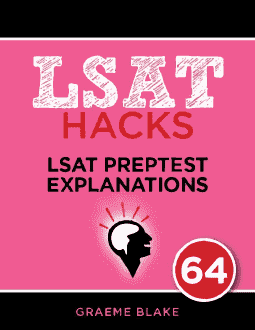QUESTION TEXT: The number of tornadoes recorded annually in North…
QUESTION TYPE: Paradox
FACTS: We spot more tornados, but weather scientists say that no more tornados are forming.
ANALYSIS: The LSAT loves to point out the difference between what we think we know and how things actually are in the real world. We see statistics, and mistake them for absolute truth. Statistics are not reality; they're just our attempt at measuring reality.
We don't see every tornado that ever occurs. Some are very small, and some happen in isolated places like deserts. Some tornados that are seen might not get reported. So official statistics do not accurately count the actual number of tornados.
The right answer should show us the difference between reality and statistics.
___________
- This doesn't matter, as long as meteorologists knew the factors well from 1953 onwards. The comparison is between 1953 and now.
- The question talks about the number of tornados. Intensity doesn't matter.
- So? It's still true that we have more than three times the number of tornados we had in 1953. This just means that the increase has slowed recently.
- Same as B. The question is about the number of tornadoes. Property damage is irrelevant.
- CORRECT. This will increase the number of tornados recorded. If authorities can't detect a tornado then they can't record it. But the number of tornados that actually occur stays the same whether or not we detect them.

Free Logical Reasoning lesson
Get a free sample of the Logical Reasoning Mastery Seminar. Learn tips for solving LR questions


Hi William,
The key in this question is “recorded.” The stimulus is asking about the number of tornadoes that have been detected or recorded. This doesn’t necessarily mean that the number of tornadoes happening has increased. Since detection was the key, I was expecting to see an answer about technology increasing our ability to record tornadoes, but the correct answer was even simpler.
(E) resolves the discrepancy by explaining how the way authorities receive information about tornadoes has changed. More people are helping authorities detect tornadoes – so people in remote areas, for example, can detect and report a tornado – if fewer citizens were reporting tornadoes before 1953, then fewer tornadoes would be recorded.
(A) does not affect the paradox. How much meteorologists knew about climactic factors wouldn’t affect the number of tornadoes recorded. It might affect their estimates, but that’s not what the question is asking for.
Using your analogy, the logic in (A) would explain the fact that Timmy has reported gaining weight in spite of diet factors remaining the same because he had been using a much less accurate scale before last Christmas. He had been gaining the same amount of weight all along, but the doctors didn’t have access to accurate data about his weight.
I hope that helps!
Good Morning!
On Prep Test # 64 Question # 6 (Resolve Paradox); I originally picked answer choice “A” for the following misconstrued reason: the stimulus mentioned the increased number of tornadoes since 1953, tripling, however, the climatic factors that create the tornadoes have not changed, according to the meteorologist. So what I interpreted to be the paradox was that since the numbers of tornadoes tripled, then this phenomenon should have been accompanied by some changes in the climatic factors. This is like saying, Timmy gain three (3) time more the amount of weight since last Christmas, however he is still eating the same amount of food.
The reason for discarding answer choice “A”, according to this post, depend on the assumption that Meteorologist knew the climatic factors well enough, prior and post 1953. However, this is exactly what this answer choice do; cast a possible reason for unknown and/or misunderstood information of climatic factors that would explain the paradox.
If Timmy’s doctor did not fully understand what caused such a weight gain, prior December, then it could be reasonably expected for them to make a illogical interpretation. But, if now they can say; ” is not food, is a hormonal thing” then that would explain why food amount is still the same.
I am having a very difficult time seeing why “E” is the right choice when “A” makes even more sense for me. I trying to see what syntax in the stimulus was ambiguously enough for me to misunderstand it and so far it has been very frustrating. I can not take the risk of not understanding the reasoning of this question out of apathy. Because I might not make the correct adjustment on my analysis and come test day and I will be at risk to commit the same mistakes.
I would appreciate any assistance you can provide me.
Thank you for your time
Have a nice
Sincerely,
William…